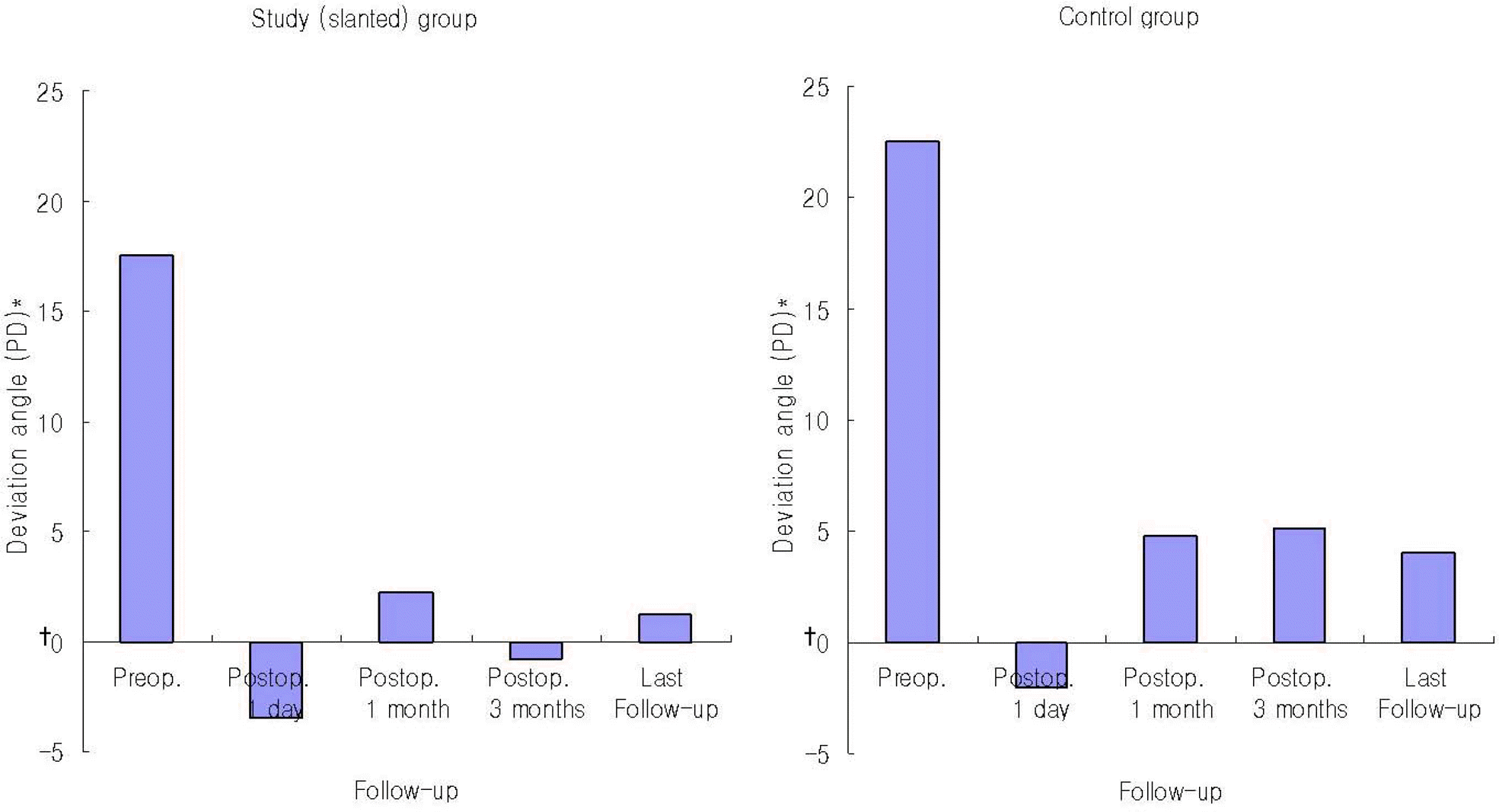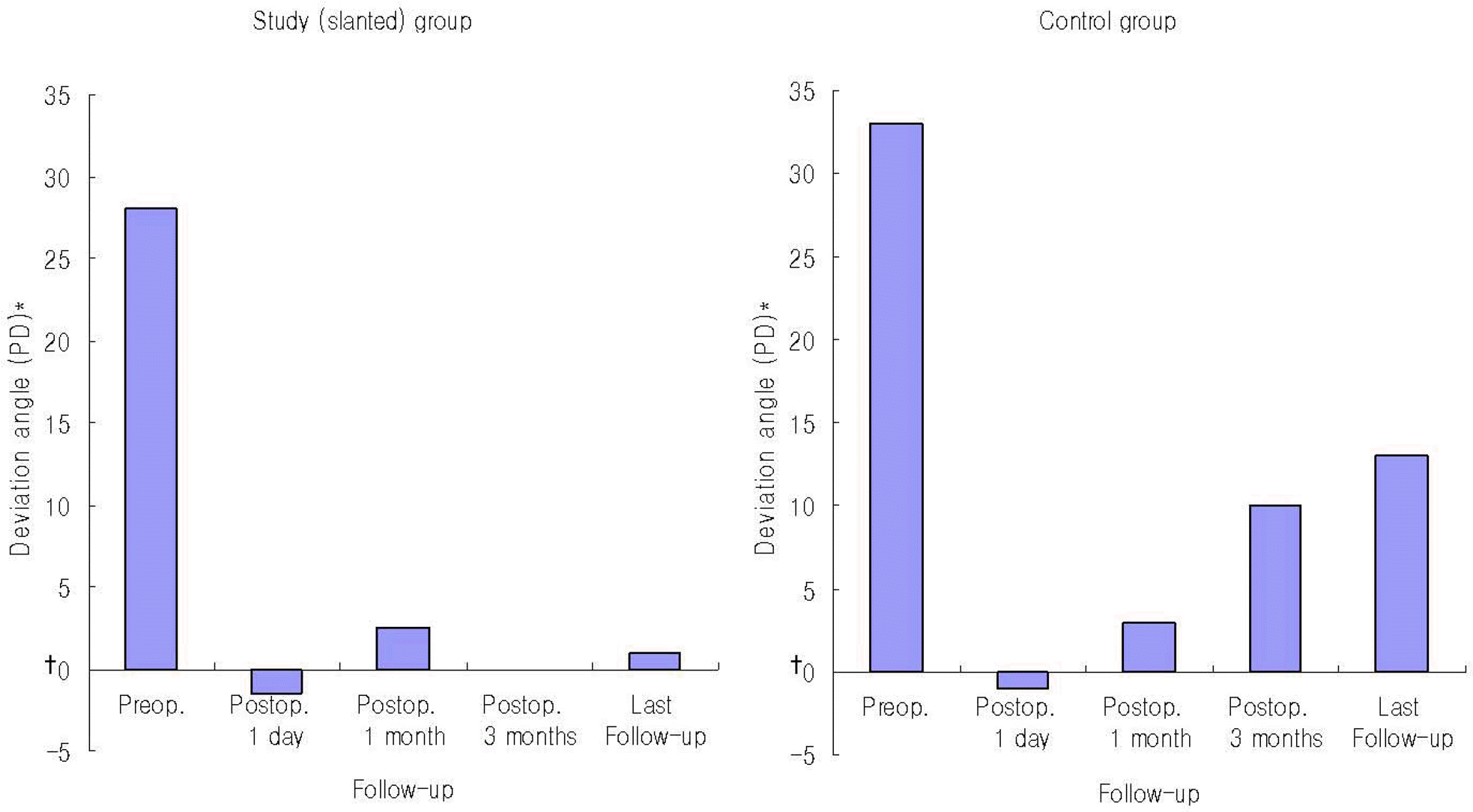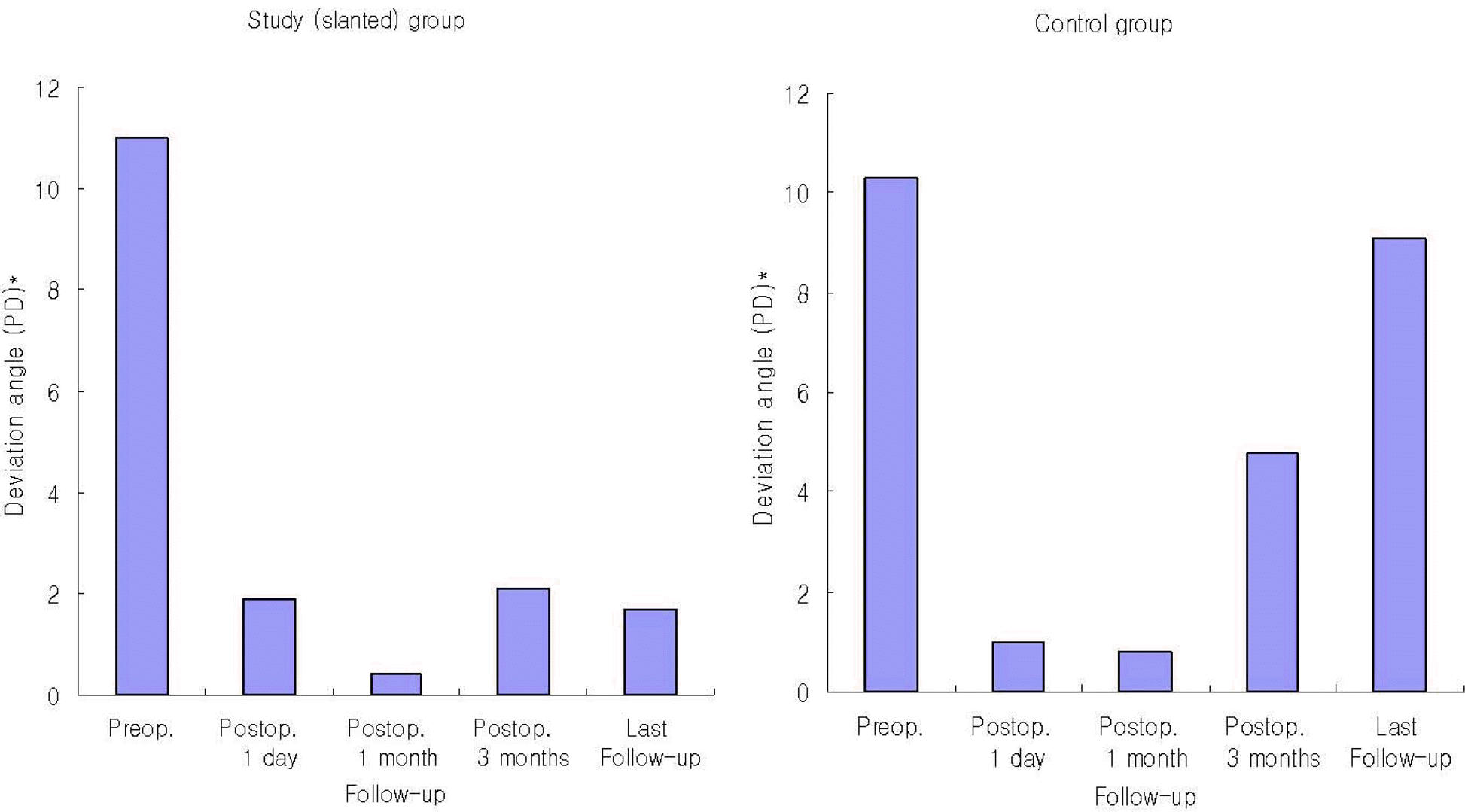Abstract
Purpose
To evaluate the efficacy of monocular slanted lateral rectus (LR) muscle recession for exotropia with convergence insufficiency.
Methods
Twenty five patients with exotropia greater at near than at versus far distance by >10 prism diopters (PD), were divided into two groups: 15 patients who underwent monocular slanted LR recession (study group), and 10 patients who underwent monocular standard LR recession (control group). In the study group, the lower horn of the LR was recessed according to near deviation, the upper horn was recessed according to distance deviation. In the control group, monocular LR was recessed according to distance deviation. The postoperative ocular alignment at distance and near, and the difference between them, were measured and compared retrospectively. The criteria for successful outcome were postoperative residual deviation at near and distance, and the difference of 8 PD or less between the two.
Results
The mean distance deviation showed a significant postoperative reduction in both groups (P<0.001, P<0.001). The mean near deviation showed a significant postoperative reduction in both groups (P<0.001, P<0.001). The mean difference between near and distance deviation showed a significant postoperative reduction only in the study group (P<0.001, P=0.175). Successful outcome was obtained in 13 our of 15 (86.7%) patients in the study group, in 2 out of 10 (20%) patients in the control group. None of the study patients had postoperative diplopia.
References
1. Snir M, Axer-Siegel R, Shalev B, et al. Slanted lateral rectus recession for exotropia with convergence weakness. Ophthalmology. 1999; 106:992–6.

2. Kraft SP, Levin AV, Enzenauer RW. Unilateral surgery for exotropia with convergence weakness. J Pediatr Ophthalmol Strabismus. 1995; 32:183–7.

3. Rah SH, Jun HS, Kim SH. An epidemiologic survey of strabismus among school-children in Korea. J Korean Ophthalmol Soc. 1997; 38:2195–9.
4. Choi DG, Kim PS. The surgical outcome of intermittent exotropia and the prognostic factors. J Korean Ophthalmol Soc. 1998; 39:1255–63.
5. Park IK, Chang BL. The effect of monocular recession and resection in exodeviations :comparison between primary, right, left, up, down and near gaze. J Korean Ophthalmol Soc. 1998; 39:1868–72.
7. von Noorden GK. Resection of both medial rectus muscles in organic convergence insufficiency. Am J Ophthalmol. 1976; 81:223–6.

8. Kushner BJ, Richard G. Exotrophic deviations: a functional classification and approach to treatment. Am Orthopt J. 1988; 38:81–93.
9. Parks MM. Ocular Motility and Strabismus. 1st ed.Maryland: Harper & Row;1975. p. 99–111.
10. Hermann JS. Surgical therapy of convergence insufficiency. J Pediatr Ophthalmol Strabismus. 1981; 18:28–31.
12. Burian HM, Spivey BE. The surgical management of exodeviations. Am J Ophthalmol. 1965; 59:603–20.
13. Choi MY, Kim EK, Hwang JM. The prospective comparison of surgical outcomes in convergence insufficiency exotropia. J Korean Ophthalmol Soc. 2004; 45:1699–707.
14. Scott AB. Strabismus muscle forces and innervation. In : Lenerstrand G, Bach-y-Rita P, editors. Basic Mechanism of Ocular Motility and Their Clinical Implications, Wenner-Gren Center International Symposium Series(Proceedings of the International Symposium held in Wenner-Gren Center, Stockholm, June 4-6, 1974). 1st ed.Oxford, New York: Pergamon Press;1975. p. 181–91.
15. Nemet P, Stolovich C. Biased resection of the medial recti: A new surgical approach to convergence insufficiency. Binocul Vis Strabismus Q. 1990; 5:213–6.
16. Biedner B. Treatment of convergence insufficiency by single medial rectus muscle slanting resection. Ophthalmic Surg Lasers. 1997; 28:347–8.

17. Ruttum MS. Initial versus subsequent postoperative motor alignment in intermittent exotropia. J AAPOS. 1997; 1:88–91.

18. Raab EL, Parks MM. Recession of lateral recti. Arch ophthalmol. 1969; 82:203–8.
19. Ko KH, Min BM. Factors related to surgical results of intermittent exotropia. J Korean Ophthalmol Soc. 1996; 37:179–84.
20. Kim SJ. Comparison of surgical results between bilateral recession and unilateral recession-resection in intermittent exotropia. J Korean Ophthalmol Soc. 1992; 33:733–8.
Figure 1.
Change in the mean distance angles in two groups according to the follow-up times. The mean distance deviation showed a significant postoperative reduction in both groups (P 0.001, 1 by paired t-test).

PD: Prism diopters. † : -: esodeviation. +: exodeviation.
Figure 2.
Change of the mean near angles in two groups according to the follow-up times. The mean near deviation showed a significant postoperative reduction in both groups(P<0.001, P<0.001 by paired t-test), but the mean near residual exodeviation was >8 PD in control group.

PD: Prism diopters. †: -: esodeviation. +: exodeviation.
Figure 3.
Change of the mean differences between near and distance angles in two groups according to the follow-up times. The mean differences between near and distance angles showed a significant postoperative reduction only in study group (P<0.001, P=0.175 by paired t-test).

* PD: Prism diopters.
Table 1.
Database of the study (slanted) group
|
Preoperative Deviation |
Postoperative Deviation |
||||||
|---|---|---|---|---|---|---|---|
| Patient | Age (years) | XT angle∗ | Difference | Difference (LH-UHΠ) of | F/U# Period | XT angle D/N | Difference |
| No. | /Sex | D/N† in PD‡ | (N-D)§ in PD | Slanted Recession (mm) | (Months) | in PD | (N-D) in PD |
| 1 | 8/M | 6/18 | 12 | 5 | 3 | 4/4 | 0 |
| 2 | 8/F | 19/30 | 11 | 2 | 4 | 4/10 | 6 |
| 3 | 9/F | 20/30 | 10 | 2 | 3 | -2/0 | 2 |
| 4 | 9/M | 25/35 | 10 | 2.5 | 3 | 2/2 | 0 |
| 5 | 3/M | 20/30 | 10 | 1 | 6 | -2/-2 | 0 |
| 6 | 16/F | 18/30 | 12 | 1 | 3 | 6/12 | 6 |
| 7 | 5/F | 18/30 | 12 | 3 | 3 | 6/6 | 0 |
| 8 | 10/M | 14/25 | 11 | 1 | 4 | 0/0 | 0 |
| 9 | 10/F | 12/25 | 13 | 3 | 4 | -2/2 | 4 |
| 10 | 4/F | 20/30 | 10 | 1 | 12 | 2/2 | 0 |
| 11 | 8/M | 14/25 | 11 | 2 | 3 | -4/-3 | 1 |
| 12 | 7/F | 20/30 | 10 | 2.5 | 3 | 0/0 | 0 |
| 13 | 9/F | 18/30 | 12 | 2 | 6 | 6/6 | 0 |
| 14 | 27/M | 10/20 | 10 | 3 | 5 | 2/4 | 2 |
| 15 | 11/M | 25/35 | 10 | 2 | 3 | 0/0 | 0 |
Table 2.
Database of the control group
|
Preoperative Deviation |
Postoperative Deviation |
|||||
|---|---|---|---|---|---|---|
| Patient No. | Age (years)/Sex | XT angle∗ D/N† PD‡ | in Difference (N-D)§ in PD | F/U Π period (Months) | XT angle D/N in PD | Difference (N-D) in PD |
| 1 | 12/F | 14/25 | 11 | 3 | -3/6 | 9 |
| 2 | 11/F | 20/30 | 10 | 6 | 10/21 | 11 |
| 3 | 10/F | 25/35 | 10 | 3 | -4/1 | 5 |
| 4 | 10/M | 18/30 | 12 | 12 | 8/19 | 11 |
| 5 | 13/F | 28/38 | 10 | 3 | 8/18 | 10 |
| 6 | 4/M | 20/30 | 10 | 4 | 14/27 | 13 |
| 7 | 5/M | 30/40 | 10 | 24 | -1/8 | 9 |
| 8 | 10/F | 30/40 | 10 | 3 | 8/15 | 7 |
| 9 | 8/F | 25/35 | 10 | 3 | 8/19 | 11 |
| 10 | 12/F | 14/25 | 11 | 3 | -2/3 | 5 |




 PDF
PDF ePub
ePub Citation
Citation Print
Print


 XML Download
XML Download